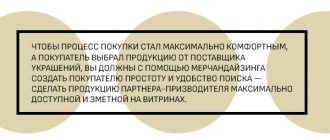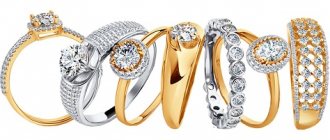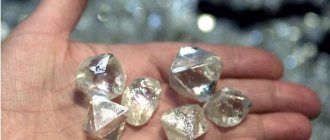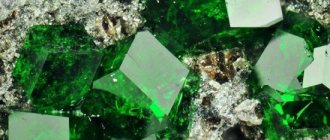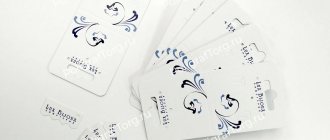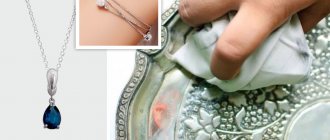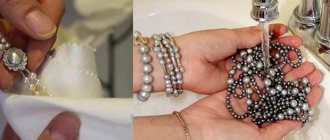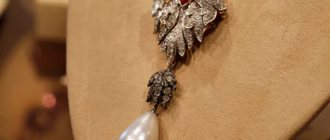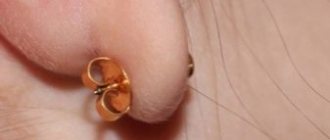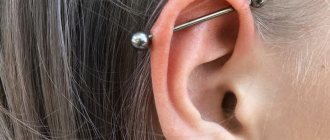Have you ever, while admiring jewelry, noticed that one of them costs much more than the rest, despite the fact that they are made from the same materials? But sometimes such differences are quite significant! But you shouldn’t think that a low price is an indicator of poor quality or careless work of the craftsman. The cost of the accessory varies depending on many features and nuances regarding the material from which it is made, the technique of work, the amount of effort expended and much more. And to help you choose a product that is both high-quality, attractive and inexpensive, a classification of jewelry was developed. Its principles, provisions and laws will be discussed in this article.
Variety of jewelry - practical classification
One of the most common ways to systematize accessories is to group them according to practical criteria. This classification method is quite widely used in the CIS countries and Europe.
When distributing accessories, craftsmen are guided by the material used in them. Thus, real jewelry includes only those that were made from noble metals - platinum, gold, silver . Such a product is decorated with any materials - from diamonds to glass - and may even have no inserts at all.
The next group is jewelry haberdashery. These are works created from non-precious alloys (aluminum, bronze, nickel) - but with silver or gold plating. They may or may not contain various decorative inserts, but in any case they will be made of non-precious substances.
And finally, the last class is metal haberdashery. This includes most items from the category of inexpensive jewelry. Both the product itself and the insert decorating it will be made of non-precious, commonly found materials - beads, leather, iron, plastic, polymer clay. However, such works are often very original and unique.
This classification is a modified version of an older system that existed before 1998. It consisted of four different classes - real jewelry, jewelry haberdashery, art and stone carvings. But due to scientific and technological progress, which entailed the invention of new materials and operating technologies, the typification was modified. Nevertheless, some masters still use it.
Formation of assortment
The assortment consists of categories of goods that will be presented in a given store, and is determined by the format of the store: the capacity of the sales area, location and target group of customers. Assortment documents
, located in the
Assortment
of the navigation panel of
the Marketing
.
When creating a new document, the user fills in the basic details:
- Effective start date
, which may not coincide with the date of the document; - The store format
is one of those defined by the user; - Product items
that will represent
assortment quotas
in this format; - Price type
—the default retail price type in this format is determined by the pricing rule for this store format.
Thus, the user indicates in one document which products will be sold in which stores, when and at what price.
Fields Operation
and
Stage
of this document determine the stage of the life cycle of goods in the assortment of each store format and the restrictions on merchandise circulation operations corresponding to this stage.
Life cycle of an assortment of products
The life cycle of a product in a store is the period of time during which a product is put up for sale, starting from its receipt and ending with its complete withdrawal from the store’s assortment. The life cycle of a product in a retail chain includes the following stages:
- Introduction to the range.
- Start of sales.
- Changing the role of goods in the assortment.
- Removal from assortment.
- Sales ban.
A change in the life cycle stage of a product item in the assortment of a store format is also recorded using the Assortment
.
Each stage of the life cycle corresponds to an Operation
of the Assortment document.
Based on the selected operation, the Stage
of the life cycle of goods in the assortment is automatically filled in, which determines the limitations of the commodity circulation processes at this stage. The table shows the correspondence of operations to stages:
| Field value Operation | Stage field value |
| Introduction to assortment | Purchases and sales are allowed |
| Introduction to assortment with delayed start of sales | Only purchases allowed |
| Change in assortment status | Purchases and sales are allowed |
| Withdrawal from assortment | Only sales allowed |
| Archive/Review | Prohibited purchases and sales |
Movement of goods between stores and store warehouses is available at any stage of the product life cycle.
Introduction to assortment
At the first stage of the product life cycle, product cards are created in the nomenclature directory and the nomenclature item is assigned to the assortment of the store format. The product category manager introduces products into the assortment, focusing on the quotas established for the product brand and category. Fullness
product category is the number of product items introduced into the assortment in a given category.
Introduction to assortment with delayed start of sales
The start date of sales may not coincide with the date of introduction into the range. This is necessary, for example, in multimedia stores when there are restrictions on the start date of sales for certain films, music discs, and computer games due to the validity period of the license. In this case, items can be ordered, receipts and transfers can be processed, but sales cannot be processed.
Change in assortment status
A new item introduced into the assortment can be regarded as a trial until the marketer is able to determine from sales statistics how successfully it is sold. A product that is in high demand can be classified as a permanent, main assortment of the store; a product that is not very successful, but necessary for creating an image, can be classified as an additional product. The role of a product item in the assortment does not impose any restrictions on product distribution, but a marketer can do a comparative analysis in terms of roles and draw certain conclusions about the shift in demand.
Role in the assortment
indicated in the tabular part of the
Assortment
for each product item:
- Constant assortment -
Products of the main assortment, the presence of which on the shelves is important and is controlled with increased attention. - Additional assortment
- Assigned to products by default. The additional assortment serves the store’s image; deviations in it are not critical. - Trial assortment -
New products included in the store’s assortment “for trial”, which have no analogues in the enterprise’s assortment, with unclear sales prospects.
A change in the selling price of a product is only indirectly related to the stage of the product’s life cycle or its role in the assortment. The assortment management functionality does not impose any restrictions on price changes. For reasons of convenience of simultaneously reviewing the role of a product item and its price, a marketer can change the Price Type
for a given product item.
From the moment these assortment changes come into effect, the sales price of goods in sales documents and in the Application of Product Prices
will be determined by the type of price indicated in the assortment.
Quickly filling in product roles in a document and changing price types can be done using the Fill
command panel tabular part:
- Fill in the role for all products
- Assign the same role for all products in the current document
Assortment role
. - Fill in the price type for all products
- Assign the same
price type
.
During the life cycle of a product item, you may need to change its role or type of selling price several times. Each change is recorded in the Assortment
with the operation
Change assortment status.
Withdrawal from assortment
Removal from the assortment, as well as introduction into the assortment, can be carried out in two stages. At the first stage of removal from the assortment, restrictions are imposed on the supply of goods: when trying to add this product item to the Order to the supplier
the program will warn the user that the product has been withdrawn from the range and its inclusion in the document is not recommended.
A warning will also be generated if you try to include the displayed product item in the Goods Receipt
, but only if it is not in the Order on the basis of which the receipt is created or the basis Order does not exist.
When automatically creating orders using Sales Analysis and order generation
removed from the assortment are excluded.
A sales ban may be relevant if it is necessary to simultaneously remove from sale goods that are dangerous to humans. Products prohibited for sale are automatically added to those created using Sales analysis and order generation
documents
Return to the supplier
with a quantity equal to the accounting balance. This stage is not mandatory in the product life cycle; some products may remain online indefinitely until they are completely sold out.
Archive/Review
If products in the assortment are still offered for sale, but orders have been stopped, the Assortment
carried out with the option
Withdrawal from assortment
in the
Operations field.
If the product is no longer ordered and put up for sale, the
Assortment
is posted with
the Transfer to Archive/Recall
Transactions
field and all operations with goods from this document in the system are stopped, the balances, if any, are returned to the supplier or written off.
Based on the document Assortment
you can create documents reflecting the movement and availability of goods:
Order to reflect shortages of goods
,
Movement of goods
,
Write-off of goods
, and also
Setting item prices.
Creation of the listed documents is available in the
Create based on drop-down menu.
Services for filling out the tabular part of a document Assortment
You can fill out the tabular part of the document with nomenclature manually using the Add
or using special selections from the
Selection
and using services from the
Fill
.
Selection by category
allows you to view items in the context of existing product categories and is called by the
Open selection by category
menu
of the Selection
tabular part of the
Assortment
.
Product Categories directory is displayed on the left side of the window.
indicating the total number of product items in a given category, their current content for a given format and product quotas.
Total
column displays the number of item names existing in the database that belong to this category, in the
Fullness
- the number of item names that are in the assortment of the store of this format, in the
Fullness + selected
- the number of item names not yet included in the
Assortment
. but included in the assortment of a store of this format.
The right side of the window displays product units related to the selected product category. By double-clicking the left mouse button, the product is added to the list of selected items at the bottom of the screen. If a product is already included in the assortment of this format, the system will issue a warning that adding this product is not required. The list of selected products is displayed in the lower table section if the Show selected products flag is selected.
The user can control the intermediate results of his work by the value in the
Filled + Selected
in comparison with the quota set for this category.
To complete the selection procedure and add selected items to the assortment, you must click the Transfer to document command.
Selection by selection
allows you to assign conditions for selecting goods into the assortment depending on the existing characteristics of the goods.
Selection is called by the command Open selection by selection
menu
Selection
of the tabular part of the document
Assortment
.
Selection can be carried out using fields available for selection, which are added to the right selection table using the Select
.
When all selection conditions are specified, you must click the Fill
Selected products
table will be filled in at the bottom of the document in accordance with the specified conditions.
In order for the selected products to be displayed in the Assortment
, you must execute the
Transfer to document command.
Selection from the Nomenclature
called by the command
Open selection
menu
Selection
of the tabular part of the document
Assortment
.
A reference book is available in the navigation window, where you can select the required type of item. Products corresponding to the current item type are displayed on the right side of the screen. By double-clicking the left mouse button, the product can be added to the selected list. After the selection is completed, you must click Transfer to document.
As a result, the products will appear in the edited
Assortment
.
To fill out the tabular part of the document, you can also use the services of the Fill
:
- Fill in the assortment format
.
The table is filled in with those products that have already been added to the assortment of stores of this format in previously completed Product Assortment
. - Fill in warehouse balances and turnover
. The table is filled in with goods that have a positive current balance and for which there was movement during the specified period.
When filling out using services, the tabular part, at the user’s request, can be previously cleared, or can be supplemented with new values. The method is selected in the dialog box that opens when filling automatically.
Precious or not - classification according to the material used
To understand what the cost of a certain accessory depends on, you need to be able to recognize the material from which it is made. It is on this basis that this typology was developed. Of course, a cast gold ring with a diamond or silver jewelry will cost much more than a craft made of nickel coated with a thin yellow plating!
So, precious metals include the following:
- gold . This ductile and soft noble metal is one of the oldest known to man. It has excellent heat and electrical conductivity and is easy to process. And the soft sparkle of the metal harmonizes perfectly with most precious stones;
- silver . It is harder than gold, but quite ductile and polishes well. Therefore, more detailed and practical works can be created from this metal;
- platinum . This metal is extremely rare. That is why it is classified as precious, although it is rarely used in jewelry - due to its hardness, platinum is difficult to process;
- palladium . Easily machined metal with a silver-gray color. It does not oxidize in air, which means that jewelry made from it will not darken over time;
- rhodium . This bluish-white metal is very hard and resistant to wear. In addition, it has extremely high reflectivity.
All other metals and alloys belong to the group of non-precious ones. But it is impossible to create such a clear classification of precious stones, because gems are evaluated based on a whole complex of signs and characteristics. Natural crystals may have inclusions or nuances of color (sometimes they cannot even be distinguished with the naked eye), which make an ordinary stone unique and exclusive - and therefore greatly increase its value.
Classification by purpose - what the product is used for
In addition to aesthetic ones, the accessories around us also perform utilitarian functions. The following typology, which is also used by our online jewelry store, is based on this principle. From the whole variety of jewelry, decorative items and everyday items, the following groups stand out:
- personal jewelry . As the name implies, these are works designed to highlight a person’s appearance - earrings, beads, pendants and pendants, rings and rings, rosary beads, medallions, etc.;
- things for the toilet . This type includes jewelry boxes, powder compacts, mirrors, and perfume bottles. Some researchers include hairpins, clips (for example, for ties or hats), cufflinks and pins in this category;
—
smoking accessories .
These are items such as pipes, mouthpieces, cigarette cases, ashtrays and similar accessories; - cutlery and crafts for table setting . These include spoons, forks, dishes, cups, decanters, coffee pots, napkin rings and even tea strainers!
- decorations for watches . They were popular in the 20th century, but even today you can see a man wearing a precious watch chain or a jewelry chronometer. And watches, bracelets, pendants and pendants with a clock mechanism are in great demand among ladies;
- souvenirs - coins, badges, medals, magnets;
- decorative elements of weapons - linings on the handles of knives and pistols, hilts, ceremonial scabbards;
— writing sets . They can be presented both as whole sets and as separate accessories - stationery knives, pens, inkwells, paperweights;
- decorative home furnishings - vases, candlesticks, lamps, clocks, panels and paintings, figurines and much more;
- items used for religious rituals - icons, incense, censers, candlesticks, baptismal fonts.
Classification and assortment of jewelry
⇐ PreviousPage 3 of 5Next ⇒
Classification of jewelry.
The main feature of the classification of jewelry products is the purpose of a particular type of jewelry; additional features include methods of finishing the product, its design features, and the material from which it is made.
According to their purpose, jewelry products are classified into groups, subgroups and types.
All jewelry products can be divided into the following groups: jewelry for women, toiletry items, room decoration items, table setting items, watches and watch accessories, smoking items, souvenirs. Each group consists of several subgroups. Thus, the group of jewelry for women is classified into 12 subgroups: bracelets, necklaces, brooches, medallions, chains, beads, necklaces, earrings, buckles, pendants, rings, sets.
One subgroup also differs from the other in the purpose of the products included in it. For example, the subgroup of rings in the group of jewelry for women includes items worn on the fingers; in the subgroup of earrings - products that are worn in the ears; in the subgroup of beads, necklaces, necklaces, chains - items worn around the neck, etc.
Each subgroup consists of species. A type is a piece of jewelry of one style, made of a certain material and having an independent article number. The number of types of jewelry amounts to thousands of items.
According to the nature of the external decoration, jewelry for women (rings, brooches, earrings, bracelets, etc.) are further classified into: smooth; with various types of artistic processing without stones and other inserts; with various types of artistic processing with stones and inserts from other materials.
Smooth products can be solid or hollow. Hollow products, while maintaining the basic shape (for example, rings), usually cost less, since less material is spent on them.
Products with various types of artistic processing without stones are characterized by the use of such technological processing methods as engraving, stamping with a pattern, application of niello, enamel, and filigree. These same products with stones undergo the above technological processing processes, but using all kinds of stones: precious, semi-precious, ornamental, synthetic, glass, plastic inserts and other materials.
Sometimes one product combines various artistic processing techniques, for example, filigree with an enamel pattern, artistic engraving of parts, niello and Dagestan embossing, etc.
According to the material used, jewelry can be classified into products made from gold, silver, platinum, palladium, combinations of these precious metals, anodized aluminum, cupronickel, brass, cast iron, bone and horn, papier-mâché, stone and other materials.
According to the design of the product, they are distinguished as follows: earrings - for pierced ears and non-pierced ears, each of these groups in turn is divided into movable, semi-movable and fixed earrings; powder compacts – bag and table compacts, etc.
The proposed classification of jewelry products has been recently developed. The introduction of this classification allows for the specialization of product groups in jewelry stores and bases according to the main consumer characteristic, to make it easier for customers to choose the right products and thereby help increase turnover, and to help merchandise experts and sellers in studying the range of jewelry products. In addition, the introduction of the developed classification causes a fundamental change in the accepted procedure for placing an assortment of jewelry products in jewelry stores, bases and warehouses. Nowadays, product sections in many jewelry stores are organized randomly; The main one is the material from which the product is made. Since most jewelry products are made from a variety of materials, each section is actually universal in its range, which is extremely inconvenient for a buyer who comes to the store to buy a specific item.
⇐ Previous3Next ⇒
Recommended pages:
Execution technique - how the jewelry is made
This sign is one of the most significant. It depends on him whether the pendant or ring you purchase will be exclusive and unique - or just another mass craft.
Today there are such varieties of execution techniques as machine, combined and manual. The machine provides for conveyor production of jewelry. A person participates in this process only at the most difficult stages, controlling quality and performing final operations. This is how unified jewelry is obtained - calibrated to the millimeter and standard. As a rule, they belong to the classic style.
The combined technology involves the manual assembly of individual parts of the accessory, obtained using machine techniques - stamping, pressing, casting. In addition, the master independently decorates the work with precious stones, overlays, adds a chain, clasp or lock, and performs final polishing and cleaning.
But, of course, it is best to buy handmade jewelry. As a rule, they are made in a single copy, which means you will be the owner of a rare and unique piece. These accessories are highly valued - after all, the craftsman spends a lot of time and effort on creating each of them, from project development to final finishing. And also unusual precious stones are often used in the work - for example, amber with inclusions or agate with an amazing pattern.
But, no matter what decoration you choose, you should like it and fit it. Only then will the accessory highlight your appearance and give you a lot of positive emotions!
